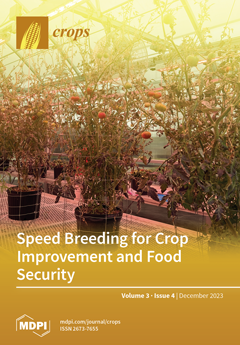Plants of the genus
Physalis are of economic interest because of their fleshy edible fruits with high nutritional value. Some species have high medicinal value with a long history of ethno-medicinal use to treat diverse diseases. There is therefore a need to correctly discriminate the different species of
Physalis for proper utilization. Although most
Physalis species have unique morphologies, their vegetative stages are identical, making it difficult to accurately identify them based on morphological characteristics. DNA barcoding has the potential to discriminate species accurately. In this study, ribulose bisphosphate carboxylase large (
rbcL) and internal transcribed spacer 2 (ITS2) regions were used to discriminate
Physalis species and to reveal their phylogenetic relationships and genetic diversity.
Physalis plant samples were collected from seven counties in Kenya based on the availability of the germplasm. The voucher specimens were identified using the botanical taxonomy method and were deposited in the University of Nairobi herbarium. Genomic DNA was isolated from leaf samples of 64
Physalis accessions and used for PCR amplification and the sequencing of
rbcL and ITS2 barcode regions. The discriminatory ability of the barcodes was based on BLASTn comparison, phylogenetic reconstruction and cluster analysis, and the determination of inter- and intra-specific distances. The nucleotide polymorphism, genetic diversity and distance of the identified
Physalis species were determined using DnaSP and MEGA 11.0 software. Species discrimination was more robust using ITS2 sequences. The species identified and discriminated by ITS2 sequences were
Physalis purpurea,
Physalis peruviana and
Physalis cordata. The
rbcL sequences were only able to identify
Physalis to the genus level. There was high interspecific and low intraspecific divergence within the identified
Physalis species based on ITS2 sequences. The ITS2 barcode is an ideal DNA barcode for use in the discrimination of species, as well as in genetic diversity studies of
Physalis accessions in Kenya.
Full article




